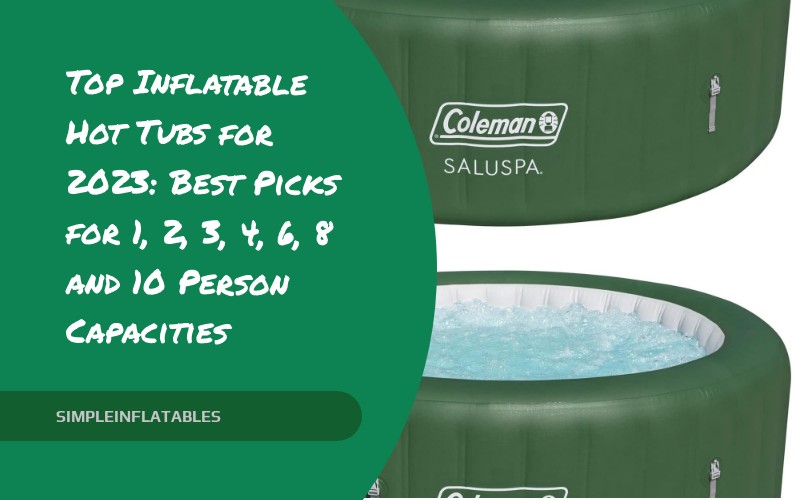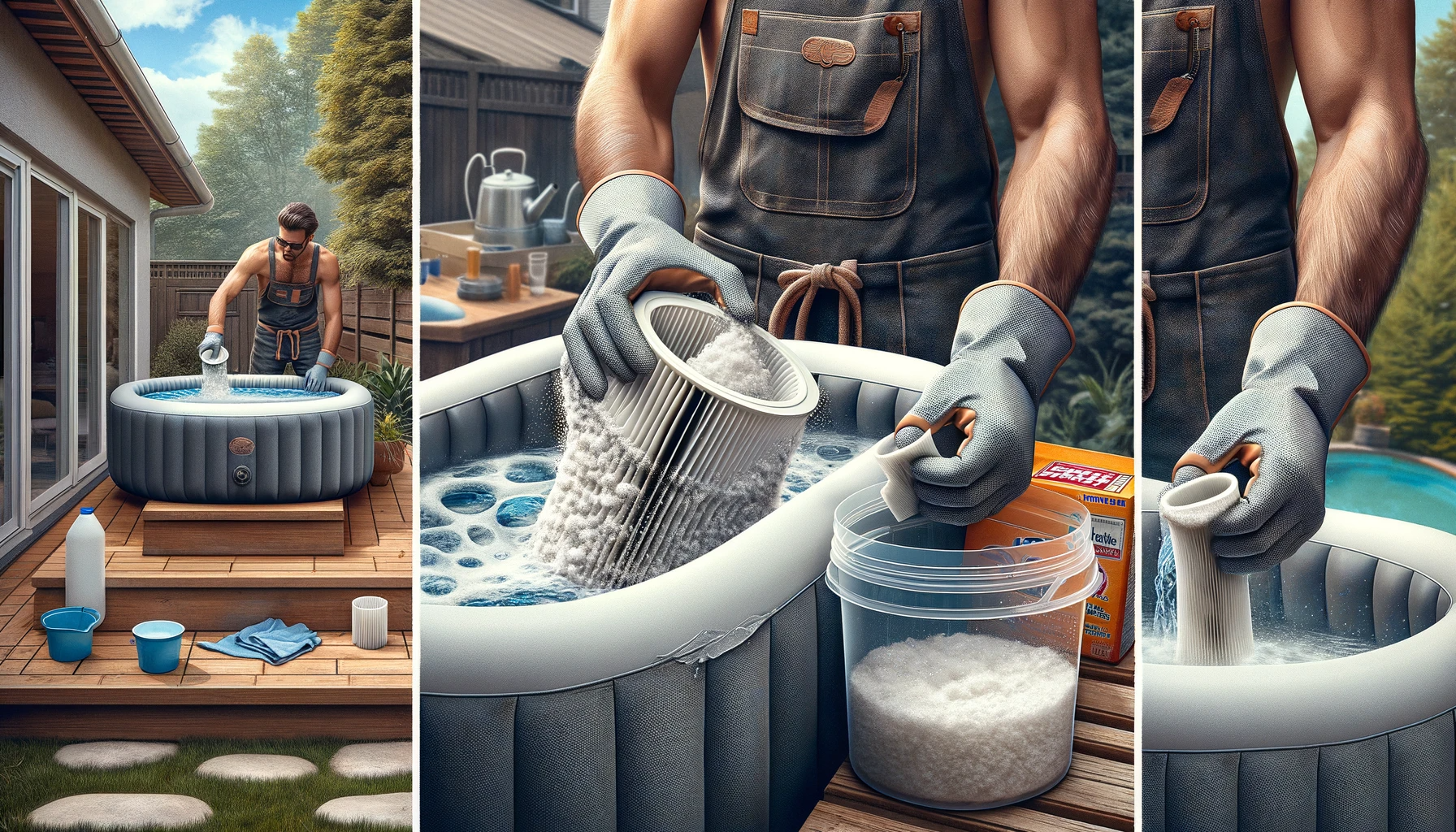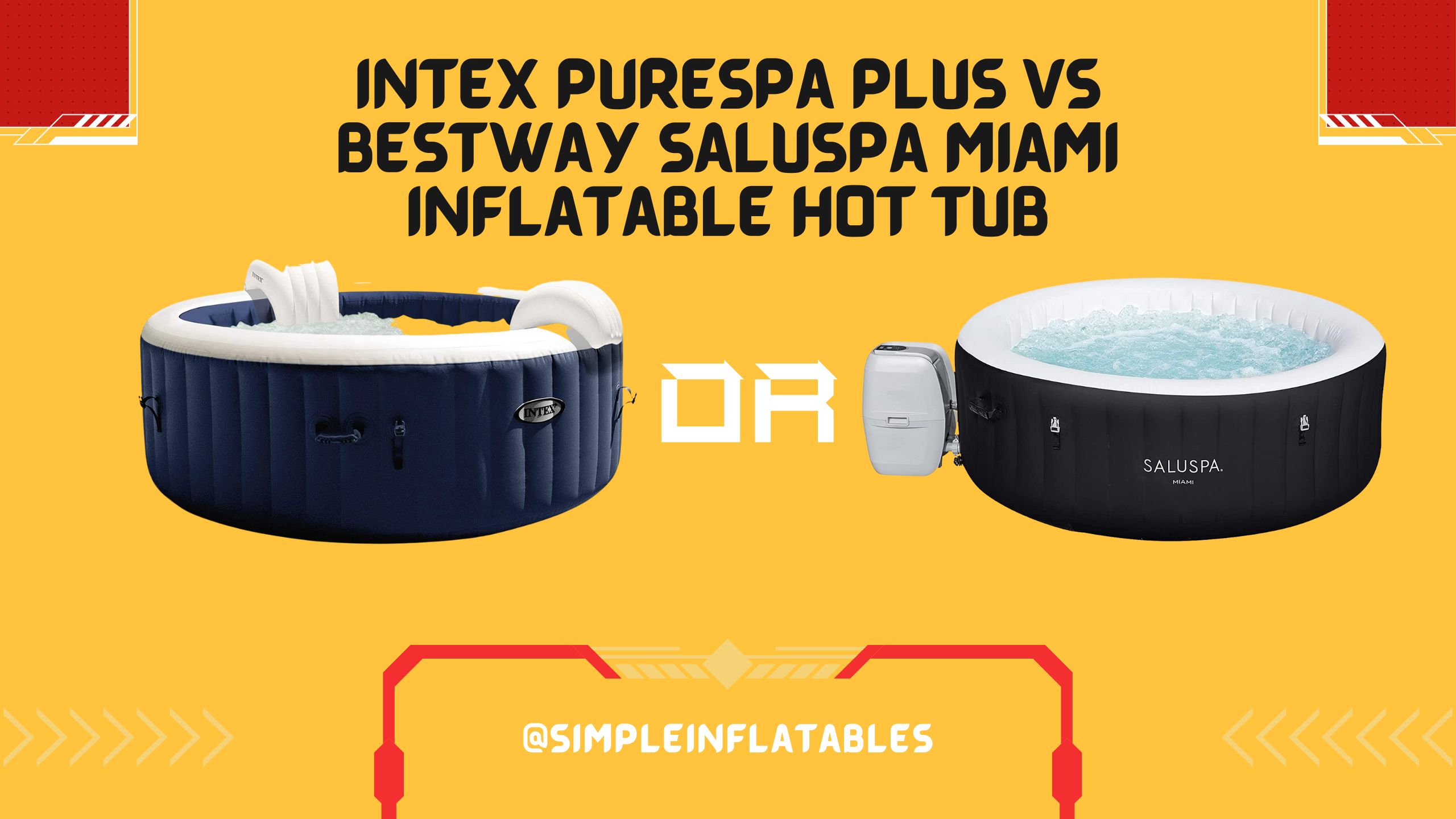When it comes to relaxation and leisure, hot tubs are an increasingly popular choice for many homeowners. However, with various options available in the market, it can be challenging to decide between an inflatable hot tub and a regular hot tub. This blog post delves into the key differences, advantages, and considerations of each type to help you make an informed decision based on your specific needs and lifestyle.
Key takeaway for inflatable hot tub vs Regular Hot tub
- Cost Differences: Inflatable hot tubs are significantly more affordable than regular hot tubs, making them a budget-friendly option.
- Installation and Portability: Inflatable hot tubs offer easy installation and portability, ideal for renters or those with limited space, unlike regular hot tubs that require a fixed, dedicated space.
- Durability and Longevity: Regular hot tubs are more durable and have a longer lifespan compared to the more vulnerable inflatable options.
- Therapeutic Features and Customization: Regular hot tubs typically come with advanced therapeutic features and customization options, which are limited in inflatable hot tubs.
- Maintenance and Upkeep: Regular hot tubs require more intensive maintenance but offer better energy efficiency and long-term value. Inflatable hot tubs, while easier to maintain, may have higher ongoing energy costs.
- Lifestyle Suitability: The choice between the two types should align with the user’s lifestyle, frequency of use, and long-term needs.
- Space Requirements: The availability of space and feasibility of installation play a crucial role in deciding between an inflatable and a regular hot tub.
- Long-Term Planning: It’s important to consider the long-term financial implications, including initial costs, maintenance, and the potential impact on property value.
- User Experience: User satisfaction varies based on the type of hot tub, with regular hot tubs typically offering a more luxurious and feature-rich experience.
- Enhanced Lifestyle and Relaxation: Regardless of the choice, both inflatable and regular hot tubs aim to enhance lifestyle, providing relaxation and enjoyment.
Understanding Inflatable Hot Tubs
Inflatable hot tubs are portable spas that can be easily set up and deflated as needed. Made primarily from high-strength PVC or similar materials, these tubs are designed to be lightweight yet durable. They typically feature an air pump to inflate the tub, a water pump for circulation, and a heating system to warm the water. The design often includes a simple control panel for temperature and jet operation. Their simplicity and ease of use make them a popular choice for those new to the world of hot tubs.
Pros of Inflatable Hot Tubs
- Cost-Effectiveness: One of the most appealing aspects of inflatable hot tubs is their affordability. They offer a spa experience at a fraction of the cost of regular hot tubs, making them accessible to a broader range of budgets.
- Portability and Flexibility: Inflatable hot tubs can be easily moved from one location to another. This portability is ideal for people who want the luxury of a hot tub without committing to a permanent location or for those who enjoy bringing their hot tub along on vacations or to seasonal residences.
- Ease of Installation: Setting up an inflatable hot tub is straightforward and doesn’t require any special tools or professional assistance. Most can be inflated, filled with water, and ready to use within a matter of hours.
- Suitability for Limited Spaces and Renters: Their compact size and non-permanent nature make inflatable hot tubs perfect for small yards, patios, and even indoor spaces. They are also an excellent option for renters who cannot make significant modifications to their living space.
Cons of Inflatable Hot Tubs
- Durability Concerns: While designed to be durable, inflatable hot tubs are more prone to damage such as punctures and wear over time compared to their hard-shelled counterparts. This can affect their longevity and require more frequent replacements or repairs.
- Limited Features and Jet Options: Inflatable hot tubs typically have fewer features than regular hot tubs. They may have a limited number of jets with less power, and often lack options like built-in seating or advanced lighting.
- Energy Efficiency and Maintenance Costs: These tubs may require more energy to heat the water, as they often have less insulation than regular hot tubs. Additionally, their filtration systems might be less sophisticated, potentially leading to higher maintenance efforts and costs.
In summary, inflatable hot tubs offer a convenient and budget-friendly option for those seeking the hot tub experience without the high cost and permanence of traditional models. However, their benefits come with trade-offs in terms of durability, features, and ongoing maintenance. Understanding these pros and cons is crucial for potential buyers to make a decision that aligns with their lifestyle and long-term expectations.
Exploring Regular Hot Tubs
Regular hot tubs, often referred to as permanent or traditional hot tubs, are fixed units designed for long-term use. They are typically constructed from durable materials such as acrylic, fiberglass, or wood. Acrylic hot tubs are known for their wide range of designs and colors, fiberglass for its strength and lightweight properties, and wood for its classic and natural aesthetic. These materials contribute to the overall sturdiness, longevity, and aesthetic appeal of the hot tubs.
Pros of Regular Hot Tubs
- Durability and Longevity: Thanks to their robust construction, regular hot tubs are known for their durability and can withstand frequent use over many years. Their materials are resistant to wear, tear, and environmental factors.
- Advanced Features and Customization: Regular hot tubs often come with a variety of advanced features such as powerful hydrotherapy jets, customizable lighting, built-in audio systems, and sophisticated filtration systems. They also offer options for customization to match personal preferences and aesthetics.
- Capacity and Size Variations: These hot tubs are available in a range of sizes, from smaller models suitable for intimate settings to larger ones that can accommodate multiple people comfortably. This makes them ideal for both personal relaxation and social gatherings.
- Energy Efficiency and Insulation: Regular hot tubs are generally more energy-efficient due to better insulation. This results in lower operational costs as they retain heat better and require less energy to maintain the desired temperature.
Cons of Regular Hot Tubs
- Higher Initial and Maintenance Costs: The initial purchase price of regular hot tubs is significantly higher than that of inflatable models. Additionally, maintenance costs, including electricity, water treatment, and potential repairs, can be substantial over time.
- Complex Installation Requirements: Installing a regular hot tub requires careful planning and often professional help. Considerations include a sturdy foundation, electrical wiring, and adequate space. This can add to the overall cost and complexity of owning a regular hot tub.
- Lack of Portability: Once installed, regular hot tubs are not easily moved. Their fixed nature means that they are a long-term commitment to a particular location, which can be a disadvantage for renters or those who plan to move.
In conclusion, regular hot tubs are a significant investment that offers durability, advanced features, and customization options. They are suitable for those looking for a long-term addition to their home, providing an efficient and luxurious spa experience. However, potential buyers should consider the higher costs, installation requirements, and lack of portability associated with these models.
Comparative Analysis of Inflatable Hot Tub Vs Regular Hot Tub
Cost Comparison: Initial Investment vs Long-term Value
- Initial Investment: Inflatable hot tubs are significantly less expensive upfront compared to regular hot tubs. This lower price point makes them an accessible option for those on a budget or those who are not ready to commit to a more substantial investment.
- Long-term Value: Regular hot tubs, though more costly initially, tend to offer greater long-term value. Their durability means they can last for many years, potentially outweighing the initial cost over time. Additionally, regular hot tubs can add value to a property, making them a worthwhile investment for homeowners.
Lifestyle Suitability
- Temporary vs Permanent Solutions:
- Inflatable hot tubs are ideal for those seeking a temporary solution or who have an uncertain living situation, like renters or individuals who frequently relocate.
- Regular hot tubs are better suited for homeowners who have a permanent space and are looking to add a lasting feature to their property.
- Frequency and Intensity of Usage:
- For occasional use, such as for seasonal enjoyment or specific events, an inflatable hot tub may suffice.
- Regular hot tubs are designed for frequent and intensive use, making them more suitable for those who plan to use their hot tub regularly for relaxation or therapeutic purposes.
Space and Installation Considerations
- Requirements for Regular Hot Tubs:
- Installation Space: Regular hot tubs require a dedicated space that can support their weight and size. This often means a reinforced deck or a specific spot in the yard.
- Professional Installation: Setting up a regular hot tub typically involves professional installation, including electrical and plumbing work, which adds to the overall cost and complexity.
- Advantages of Inflatable Tubs in Space-limited Situations:
- Space Flexibility: Inflatable hot tubs can be set up in a variety of spaces, including smaller yards, patios, or even indoors, as long as the surface is flat and stable.
- No Installation Hassles: With no need for professional installation, inflatable hot tubs can be a convenient option for those with limited space or for whom permanent installation is not feasible.
In summary, when comparing inflatable and regular hot tubs, it’s essential to consider the balance between initial costs and long-term value, how the hot tub aligns with your lifestyle needs, and the practicalities of space and installation. Both options have distinct advantages, and the best choice depends on individual circumstances and priorities.
Key Features and User Preferences in Hot Tubs
A. Jet Systems and Therapeutic Features
- Inflatable Hot Tubs:
- Typically feature basic jet systems that provide a gentle, soothing experience.
- The jets in inflatable models are often fewer in number and less powerful than those in regular hot tubs.
- Ideal for basic relaxation and enjoyment, but may not offer the therapeutic benefits sought by some users.
- Regular Hot Tubs:
- Equipped with advanced, powerful jet systems that can be adjusted for intensity and direction.
- Offer a range of therapeutic benefits, including muscle relaxation, pain relief, and improved circulation.
- Often include options for targeted hydrotherapy, catering to users with specific therapeutic needs.
Customization and Additional Amenities
- Inflatable Hot Tubs:
- Limited in terms of customization and additional features.
- Some models may offer basic LED lighting or simple seating arrangements.
- Generally, lack options for personalization in terms of aesthetics and functionality.
- Regular Hot Tubs:
- High degree of customization available, from the choice of materials and colors to the layout of jets and seating.
- Can include a variety of amenities like built-in sound systems, lighting options, waterfalls, and even television screens.
- Allow for a personalized spa experience tailored to individual preferences and needs.
User Experiences and Satisfaction
- Inflatable Hot Tubs:
- Often praised for their convenience and ease of use.
- Users appreciate the flexibility and the option to store the tub away when not in use.
- Some users may find the limited features and less robust jet systems a drawback, especially if seeking a more therapeutic or luxurious spa experience.
- Regular Hot Tubs:
- Generally, receive high marks for comfort, durability, and the range of features offered.
- Users appreciate the ability to customize their experience and enjoy the various therapeutic benefits.
- The higher cost and installation requirements can be a downside for some, but many find the investment worthwhile for the enhanced experience.
In conclusion, when choosing between an inflatable hot tub and a regular hot tub, it’s crucial to consider the key features and how they align with user preferences and needs. While inflatable hot tubs offer convenience and flexibility, regular hot tubs provide a more luxurious and therapeutic experience, with extensive customization options. User satisfaction tends to align closely with these features and the individual’s expectations and requirements from their hot tub experience.
Maintenance and Upkeep of Hot Tubs
Maintenance Requirements for Each Type
- Inflatable Hot Tubs:
- Regular Cleaning: Essential to keep the water clean and the tub free from debris. Involves periodic draining and wiping down the interior.
- Water Treatment: Regular testing and balancing of water chemistry, including pH levels and sanitizer levels, are necessary.
- Inspection for Damage: Regular checks for punctures or air leaks are important to ensure longevity.
- Air Pump Maintenance: Keeping the air pump in good condition is crucial for proper inflation and performance.
- Regular Hot Tubs:
- Comprehensive Water Care: More sophisticated water treatment systems require consistent monitoring and balancing of chemicals.
- Filter Cleaning/Replacement: Regular cleaning or replacement of filters is necessary to maintain water clarity and hygiene.
- Jet and Plumbing Maintenance: Periodic checks and maintenance of jets, pumps, and plumbing systems are required to ensure efficient operation.
- Surface Cleaning and Inspection: Regular cleaning of the tub surface and inspection for any cracks or wear in the material.
Long-term Care and Durability Tips
- Inflatable Hot Tubs:
- Proper Storage: When not in use, store the hot tub in a cool, dry place to prevent material degradation.
- Avoid Sharp Objects: To prevent punctures, ensure the area around the hot tub is free from sharp objects.
- Sun Protection: Use a cover or place the tub in a shaded area to protect from UV damage.
- Regular Hot Tubs:
- Regular Professional Servicing: Annual or bi-annual servicing by professionals can help maintain the tub’s condition and functionality.
- Use Quality Covers: High-quality, insulated covers can protect the tub from debris and help in maintaining water temperature.
- Winterization: In colder climates, proper winterization is crucial to prevent damage from freezing temperatures.
Energy Consumption and Efficiency
- Inflatable Hot Tubs:
- Tend to be less energy-efficient due to thinner walls and lack of substantial insulation.
- Frequent heating of water, especially in colder climates, can lead to higher energy consumption.
- Regular Hot Tubs:
- Generally more energy-efficient thanks to better insulation and more advanced heating systems.
- Incorporating energy-saving practices, like using a well-insulated cover and lowering the temperature when not in use, can further enhance efficiency.
Proper maintenance and upkeep are crucial for both inflatable and regular hot tubs to ensure their longevity, safety, and performance. Regular hot tubs typically require more intensive maintenance but offer greater durability and energy efficiency. In contrast, inflatable hot tubs demand less complex care but may have higher ongoing energy costs and are more vulnerable to damage over time. Understanding these maintenance needs is essential for owners to enjoy a safe and relaxing hot tub experience for years to come.
Making the Right Choice: Inflatable Hot Tub Vs Regular Hot Tub
Assessing Personal Needs and Preferences
- Purpose of Use:
- Determine whether the hot tub is for relaxation, socializing, therapeutic purposes, or a combination of these.
- Consider personal preferences for features like jet strength, seating comfort, and aesthetic appeal.
- Frequency of Use:
- Evaluate how often the hot tub will be used. Occasional use may lean towards the convenience of an inflatable tub, while regular use may justify the investment in a regular hot tub.
- Personal Lifestyle:
- Consider the impact of lifestyle factors such as family size, social habits, and whether the tub is for personal tranquility or hosting gatherings.
Budget Considerations and Long-Term Planning
- Initial Investment:
- Compare the upfront costs of both types. An inflatable hot tub has a lower initial price, making it a cost-effective option for short-term use or limited budgets.
- Ongoing Costs:
- Factor in the long-term costs, including maintenance, repairs, energy consumption, and potential upgrades for both types.
- Regular hot tubs, while more expensive upfront, may offer better long-term value due to durability and efficiency.
- Resale Value and Property Impact:
- Consider if a regular hot tub can add value to your property, especially for homeowners planning to sell in the future.
Space Availability and Installation Feasibility
- Space Constraints:
- Evaluate the available space. Inflatable hot tubs can be placed in a variety of settings with minimal requirements, whereas regular hot tubs need a dedicated, structurally sound space.
- Installation Requirements:
- Assess the feasibility of installing a regular hot tub, considering factors like access to plumbing, electrical work, and the need for a solid foundation.
- Remember that inflatable hot tubs offer ease of installation with no permanent changes needed.
- Adaptability and Mobility:
- For those who rent, move frequently, or foresee changes in their living situation, an inflatable hot tub offers greater flexibility.
In conclusion, making the right choice between an inflatable hot tub and a regular hot tub depends on a careful evaluation of personal needs, budget, and available space. Both options have their unique benefits and drawbacks. By considering factors such as usage, lifestyle, long-term financial implications, and space requirements, prospective buyers can make a decision that best suits their specific circumstances and enhances their overall quality of life and home enjoyment.
Conclusion: Inflatable Hot Tub Vs Regular Hot Tub
- Inflatable Hot Tubs offer affordability, portability, and ease of installation, making them ideal for budget-conscious individuals, renters, or those with limited space. However, they may lack in durability, advanced features, and energy efficiency.
- Regular Hot Tubs are characterized by their durability, wide range of features, and customization options. They are suited for frequent use and offer therapeutic benefits but come with higher initial and maintenance costs, complex installation requirements, and are not easily movable.
Final Thoughts on Selecting the Suitable Hot Tub
Selecting the right hot tub is a balance of personal preferences, lifestyle needs, and practical considerations. It’s important to weigh the advantages and disadvantages of both inflatable and regular hot tubs in the context of your specific situation. Whether it’s the flexibility and simplicity of an inflatable hot tub or the luxury and longevity of a regular hot tub, your choice should align with your long-term satisfaction and overall well-being.
Encouragement for Enhanced Lifestyle and Relaxation
Regardless of the choice between an inflatable or a regular hot tub, the ultimate goal is to enhance your lifestyle and provide a space for relaxation and enjoyment. A hot tub can be a haven for personal retreat, a center for social gatherings, and a source of physical and mental wellness. Embrace the opportunity to add this element of comfort to your life, knowing it can offer a meaningful impact on your daily routine and overall well-being.
In summary, both inflatable and regular hot tubs have unique qualities that cater to different needs and preferences. By considering all aspects – from cost to lifestyle implications – you can make a well-informed decision that enriches your home and life with relaxation and joy.



